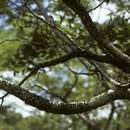en
names in breadcrumbs


Pilostyles is a genus of flowering plants in the family Apodanthaceae. It includes about 11 species of very small, completely parasitic plants that live inside the stems of woody legumes.[1][2] Plants of this genus are sometimes referred to as stemsuckers.[3]
The plants completely lack stems, roots, leaves, and chlorophyll. While not flowering, they do not resemble most plants, living entirely inside the host as " [...] a mycelium-like endophyte formed by strands of parenchyma cells that are in close contact to the host vasculature".[4] Their presence is only noticeable when the flowers emerge out of the stems of the host plant.[2]
Pilostyles is dioecious, with separate male and female plants.[5] Male and female plants are not commonly known to inhabit the same host.[6] Flowers are two or three millimeters wide and in some species each female flower can produce over 100 seeds, which are less than 1mm long.[7] [6]
Species are found in several countries, with a discontinuous distribution: species have been found in the United States, Mexico, Venezuela, Iran, Syria, and Australia.[8]
Species include:[1]
The genus was formerly considered a member of Rafflesiaceae, and was re-classified after new DNA evidence[9][8]
Pilostyles is a genus of flowering plants in the family Apodanthaceae. It includes about 11 species of very small, completely parasitic plants that live inside the stems of woody legumes. Plants of this genus are sometimes referred to as stemsuckers.
The plants completely lack stems, roots, leaves, and chlorophyll. While not flowering, they do not resemble most plants, living entirely inside the host as " [...] a mycelium-like endophyte formed by strands of parenchyma cells that are in close contact to the host vasculature". Their presence is only noticeable when the flowers emerge out of the stems of the host plant.
Pilostyles is dioecious, with separate male and female plants. Male and female plants are not commonly known to inhabit the same host. Flowers are two or three millimeters wide and in some species each female flower can produce over 100 seeds, which are less than 1mm long.
Species are found in several countries, with a discontinuous distribution: species have been found in the United States, Mexico, Venezuela, Iran, Syria, and Australia.
Species include:
Pilostyles aethiopica Welw. Pilostyles berteroi Guill. Pilostyles blanchetii (Gardner) R.Br. Pilostyles boyacensis F.Gonzáles & Pabón-Mora Pilostyles coccoidea K.R.Thiele Pilostyles collina Dell Pilostyles hamiltonii C.A.Gardner Pilostyles haussknechtii Boiss. Pilostyles maya P.Ortega, Gonz.-Martínez & S.Vásquez Pilostyles mexicana (Brandegee) Rose Pilostyles thurberi A.GrayThe genus was formerly considered a member of Rafflesiaceae, and was re-classified after new DNA evidence